|
1.
CENTRAL/ WEST AFRICA
West African markets maintain stability
Market stability has been maintained in West Africa
throughout June in price and volume. Asian buyers have
continued to make regular purchases and request
shipments of a range of favored species that are rather
more limited than in 2008 and earlier. There are some
small signs of more interest from European buyers where
there have been reports of very low stocks. Ordinarily, this
would be an indicator of an imminent resurgence in new
purchases but given the present more difficult financial
conditions, there is some reluctance to commit beyond
small volumes against orders already in hand. Buyers do
seem to be well aware that any return to even moderate
volume trading levels could trigger very long lead times
for new contracts.
Producers, on the other hand, have tailored production to
maintain stability and cater for the current demand. They
are not speculating if or when European buyers will return
to the market. Some producers reported as still having
some quite large overlying stocks of certain species. One
positive trend in the market is the increasing demand for
certified timber. The Netherlands and the UK have taken
the lead in demanding certified timber and the UK
government in particular is becoming more active in
regulating the use of certified timber in central and local
government projects. Some African producers have
engaged in the certification process and are able to supply
fully certified timbers. Such producers are in the minority,
however, as most mills have not seen enough demand for
certified timber to push them to undertake certification
initiatives.
Looking at the first half of the year, many West African
producers may well feel they made the right move early
enough to survive an extremely difficult six months, with
the prospects for the second half perhaps rather better than
expected. The effects of the global economic downturn on
African timber industries may have not yet impacted fully
on the economies of those countries that depend heavily
on revenues from timber and timber products exports.
Nevertheless, mill closures and production cut backs have
been occurring over the last six months, resulting in largescale
unemployment for a number of workers in the timber
sector.
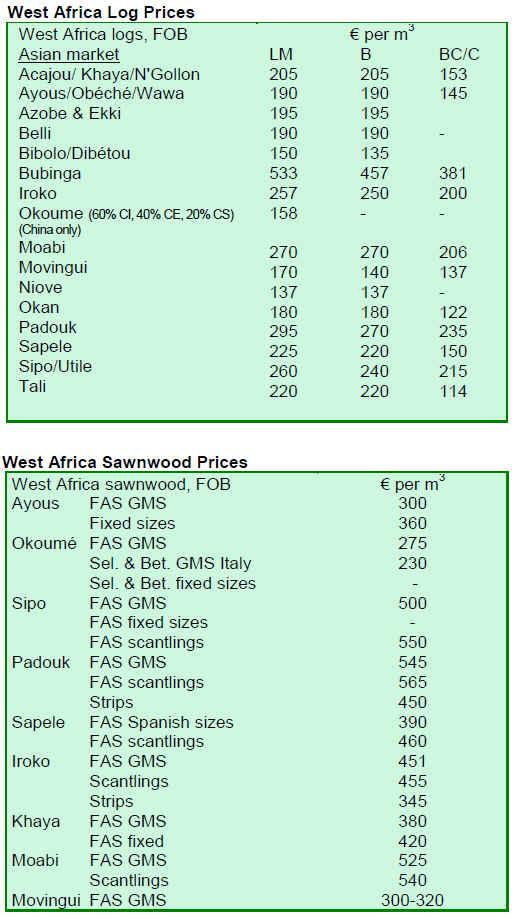
2. GHANA
Ghana announces removal of taxes on imported timber
At an ITTO-sponsored conference in Ghana, Ghana¡¯s Vice
President John Mahama announced the removal of taxes
on logs and sawn timber in an effort to boost the timber
industry. He explained that a slump in demand for the
country¡¯s timber products, particularly mahogany and
odum, had forced some of the country¡¯s lumber and
veneer prices down. These facts were supported by a study
on intra-African trade launched by ITTO at the
conference. He encouraged African countries to work
together to offset the downturn in timber markets and
encourage the free flow of trade.
Ghana sees no significant change in market conditions
There have been no significant changes in price levels
during the second quarter of 2009, as markets have yet to
recover from the effects of the global financial crisis.
Exporters, especially small to medium scale enterprises,
are finding it very difficult to secure export contracts and
buyers are taking advantage of the situation to close
contracts at much lower prices. Lumber prices have
dropped between EUR10/m³ and EUR50/m³ below the
TIDD Minimum Guiding Selling Prices (GSP) depending
on the species.
Notwithstanding the above, prices for tertiary timber
products are encouraging. Prices of dowels, parquet
flooring, lippings and mouldings in general were either at
or a little above the GSP during the quarter under review
but the volume of timber in contracts was very low. These
products altogether contributed 2.19% of the total volume
of wood products exported during the quarter.
Plywood, which is mainly exported to countries within the
West African sub-region, is the only product that has
maintained price levels since December 2008. During the
quarter under review prices were between USD5/m³ and
USD20/m³ above the TIDD Minimum GSP depending on
the thickness of the plywood.
Non-traditional exports surge despite global crisis
In spite of the global financial crisis, non-traditional
exports (NTEs) performed better in the first quarter of the
year compared to the same period in 2008. Data available
from the Ghana Export Promotion Council (GEPC)
indicated that exports during the period amounted to
USD316.6 million, a growth of 35.5% over revenue of
USD238.9 million for the same period in 2008.
Processed and semi-processed products contributed about
86% to the revenue. Cocoa paste, plastic products, cocoa
butter and canned tuna were among the 10 leading
products exported during the period. The EU and
ECOWAS were the major destinations for NTEs,
accounting for 44.6% and 35.7% of the market
respectively.
In a two-day workshop to examine the negative effects of
the global economic downturn on the export business
community, the Executive Secretary of GEPC, Mr. Collins
Boateng, said NTEs are not entirely safe from the impact
of the global economic crisis. Hence, the Council was
focused on improving market access for Ghana¡¯s NTEs in
the West Africa region and also to boost intra-African
trade particularly to South Africa, to offset reductions in
exports to the EU market.
Ghana¡¯s inflation eases marginally
Ghana¡¯s inflation slowed to 20.06% in May 2009, the first
time in three months, down from the April 2009 rate of
20.56%. The rate at which general prices of goods and
services increased in the economy thus also reduced
during that period, according to the government¡¯s Deputy
Statistician, Prof. N N Nsowah-Nuamah. The reduction
was largely due to the downward pressure exerted on
goods and services by the non-food components of the
Consumer Price Index (CPI). A reduction was expected at
this time of the year, since food production picks up
during this time and the National Petroleum Authority has
also reduced fuel prices by 10%. Mr. Nsowah-Nuamah
said although the decreasing trend of inflation could
continue for sometime, the recent 30% increment in fuel
prices leaves consumer behavior less predictable.
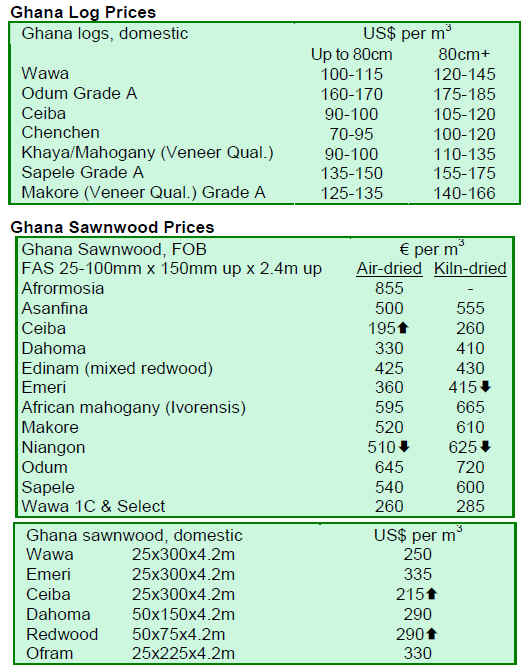
3.
MALAYSIA
Malaysian government reins in timber smuggling
According to the Btimes, Deputy Minister of Plantation
Industries and Commodities, Mr. Hamzah Zainuddin,
reiterated the federal government¡¯s commitment to
addressing the problem of timber smuggling into and
within the country. He added that six arrests for timber
smuggling have been made to date, with timber
confiscated worth RM19 million.
Over the last two months, law enforcement officers from
the Malaysian Timber Industry Board (MTIB) intercepted
timber smuggled into the country from India via Port
Klang and the Port of Penang. A total of 11 tons of timber
were confiscated with a total face value of RM10 million.
Meanwhile, Malaysia¡¯s timber exports slipped 20% in the
first quarter of 2009 compared to the first quarter of 2008,
with exports amounting to RM4.1 billion. Total exports
for 2008 stood at RM22.79 billion.
STIDC reports slump of 27% in exports
The Sarawak Timber Industry Development Corporation
(STIDC) reported that Sarawak¡¯s exports of logs and
timber products declined 27.3%, for the first four months
of 2009 compared to the same period in 2008, dropping in
value from RM2.56 billion to RM1.87 billion. As noted in
Bernama news, Sarawak exported RM940 million of
plywood; RM470 million of logs; RM230 million of sawn
timber; and RM230 million of dowels, mouldings, particle
board, medium density fibreboard (MDF), laminated
veneer lumber, veneer, woodchips and blockboard for the
period January 2009 to April 2009.
Plywood exports slid 32.19% from 1,108,305 m³ to
751,538 m³, while sawnwood exports by volume tumbled
35.45% from 385,287 m³, to 248,692 m³. Japan remains
Sarawak¡¯s main buyer of plywood at RM480 million, with
South Korea following at RM140 million. The volume of
plywood imported by the Gulf Cooperation Countries
(GCC), Taiwan and the Philippines stood at 74,859 m³,
62,494 m³ and 17,509 m³, with a value of RM100 million,
RM70 million and RM20 million respectively.
As for the exports of logs from Sarawak, India remains the
largest buyer, absorbing a total export market share of
63%, with a volume of 599,254 m³, marginally down from
a volume of 602,795 m³ in 2008. Sarawak¡¯s log exports by
volume to Taiwan fell by 40.9%, China by 59.6% and
Vietnam by 13.3%. For sawnwood, declines by volume
were registered for Thailand (40.9%); the GCC (29.1%)
and Taiwan (52.4%). The exception to this trend was
exports to the Philippines, which increased 16.4%.
The STIDC maintained that the market's future outlook at
the end of April 2009 was positive with the average unit
price of logs, sawn timber and plywood holding stable,
and the average unit price of dowels, MDF and woodchips
positive.
More than half of Malaysia¡¯s total land area covered in forests
Deputy Natural Resources and Environment Minister Mr.
Joseph Kurup said that presently Malaysia has nearly 20
million hectares of forest, covering 59.5% of its total land
area. As reported in Bernama, 5.85 million hectares of the
total amount is in peninsular Malaysia; 4.40 million
hectares is in Sabah; and 9.24 million hectares is in
Sarawak. A total of 14.31 million hectares, or 73.4% are
forest reserves, and 5.18 million hectares, or 26.6%, are
government-owned and private-owned land.
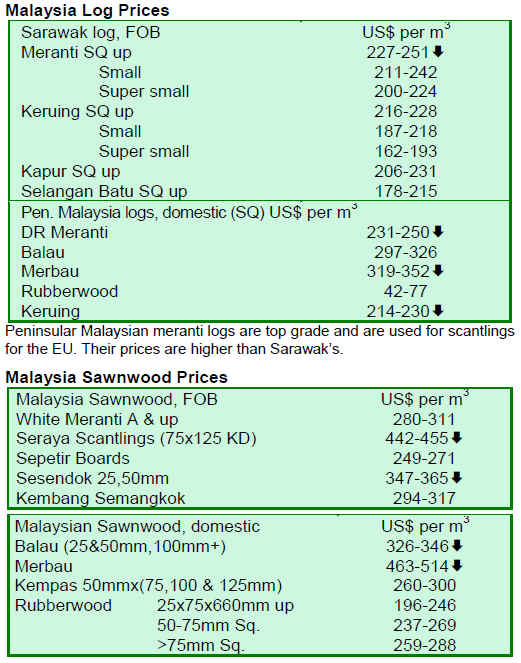
4.
INDONESIA
Economic downturn continues to stifle furniture exports
The global economic downturn continues to negatively
affect Indonesia, with the Indonesian Central Statistics
Agency reporting a decline of 28% in timber exports for
first quarter 2009 in comparison with the same quarter of
2008. The Agency reports timber products were exports
worth USD559.7 million for the first quarter of 2009.
A sharp decline of 23.2% was registered in the export
volume of wooden furniture, doors and window frames,
reported The Jakarta Globe. Similarly, the value of
exports declined by 15.8% when compared to the value of
first quarter 2008 exports (USD375.8 million).
The decline in paper and pulp exports by volume was
smaller at 3.1%, representing a volume of 32,747 MT, but
steeper by value at 17%, or USD183.9 million. Indonesia¡¯s
exports of furniture and handicrafts in 2008 were valued at
about USD2 billion. The share to the US market was 30%,
while the EU market received 40% of total exports. The
Indonesian furniture industry employs up to 11 million
workers, with 7.5 million of them located in Java.
New forestry investments climb
New investments in the Indonesian forestry industry over
the first five months of 2009 rose to Rp. 1.2 trillion
(USD116 million), due in part to new reforms in
government regulations for the forestry industry sector,
according to a forestry ministry official. As reported in
The Jakarta Post, this rise is compared to the year 2008,
when total investment for the same sector was only Rp.
861 billion and committed by a total of 11 companies.
Mr. Hadi Daryanto, a director-general of the forestry
ministry, noted that within the first five months of 2009, a
total of 14 companies successfully applied to develop new
forestry areas worth Rp 851.6 billion. An additional four
companies had secured investments worth Rp 366 billion
and would focus on developing and expanding industrial
production capacity. He added that these companies were
set to produce sawnwood, plywood, veneer, and wood
chips in Sumatra, Java, Kalimantan, Sulawesi, and Papua.
About 65,000 jobs in the forestry product sector are
expected to be created by these new investments. The
following are among the 18 new companies: PT Moranaga
in North Sumatra; PT Papua Indonesia Lestari in Papua;
PT Selemoi Timber Indonesia in West Papua; PT Elbana
Abdi Jaya in South Kalimantan; PT Elbana Abdi Jaya in
South Kalimantan; PT Wahana Lestari Makmur Indonesia
in South Sumatra; PT Cipta Wijaya Mandiri in Central
Java; and PT Sejahtera Usaha Bersama in East Java.
Companies are no longer required to apply for new
licenses if they move into new product development such
as wood pellet production, to facilitate licensing processes.
In addition, in line with South Korea¡¯s objective of
pursing a green economic policy, a number of South
Korean companies had expressed interest in developing
more than 700,000 hectares of industrial forests in
Indonesia, of which 200,000 hectares would be used to
meet raw material requirements for energy production in
South Korea. This would replace 5% of the 8 million MT
of coal used in South Korea with biomass.
Indonesia sets new limits to raw exports of rattan
In a response to complaints by furniture and handicraft
manufacturers concerning the shortage of raw material
supply of rattan, the Indonesian government will issue a
new export regulation to limit the export of rattan by
producers. Only two major rattan producing regions will
be exempted from this regulation, said Mr. Ardiansyah
Parman, the Secretary General of the Ministry of Trade.
According to The Jakarta Globe, under the new rattan
export regulation, rattan producers from Kalimantan and
Sulawesi will be required to direct 70% of their production
to the domestic market, while the remaining 30% may be
utilized for export purposes. However, rattan producers
outside these two regions are banned from exporting any
rattan they produce.
Moreover, rattan of a higher quality but smaller in
diameter (between 4 mm to 16 mm in width) will be
barred from being exported. This regulation will not,
however, be applied to the domestic market.
Indonesia is the world¡¯s largest rattan exporter, accounting
for up to 80% of the world¡¯s total and export products
worth a value of USD200 million.
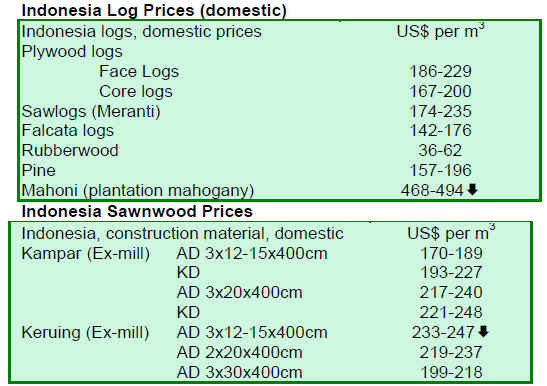
5.
MYANMAR
Market moves slow in Myanmar
The export market is moving slowly. Some buyers for
India say the market for pyinkado logs is improving, but as
for teak, some experts believe the inflexible pricing policy
of the Myanmar Timber Enterprise (MTE) could be a
major constraint, unless the grading system is revised.
MTE announced that secondary processed wood products
from state-owned MTE sawmills and wood industries
would be shipped on FOB basis. This is a relaxation of the
recent decision that all shipments except purchases from
the tender sales would be shipped ¡®Ex-Works¡¯. Buyers
hope further relaxation of direct sale contracts will follow,
to energize the currently sluggish market.
Firewood shortages addressed by Ministry of Forestry
The Seven Days News Journal recently reported the details
of an interview with a Ministry of Forestry official
discussing the countries ¡®Dry Zone Greening Department¡¯.
The dry zone is situated in central Myanmar and
comprises 54 townships in the three divisions: Mandalay,
Sagaing and Magway in central Myanmar. The total land
area of these divisions is about 8.17 million hectares
(about 20.18 million acres). Annual precipitation is
estimated to be only about 50 days per year. The firewood
requirement per year for these divisions is 5,088 thousand
cubic tons. It is reported 200,000 acres of woodlots had
been planted in FY 2008-09 in the area and it is expected
about 1.05 million acres of woodlots will be established
within a 30-year period. The department is also
responsible for reforesting the dry green zone.
Additionally, the department will supply energy efficient
wood stoves in the area to reduce the consumption of
firewood. Briquette manufacturing is also done in the saw
mills to help relieve firewood shortages. Population boom,
socio-economic development and changes in land-use
patterns are said to be major challenges facing this area.
Tree planting initiatives continue after Cyclone Nargis
The Weekly Eleven reported that the Yangon City
Development Committee will be growing 100,403 trees
starting 1 June until end August 2009 to replenish trees
destroyed by Cyclone Nargis in 2008. The trees are from 1
to 3 years old, have been grown in various nurseries in
Yangon and will take about 3 to 5 years to provide
sufficient shade for city dwellers. The Committee has
asked for public participation to maintain the health and
vitality of the trees.
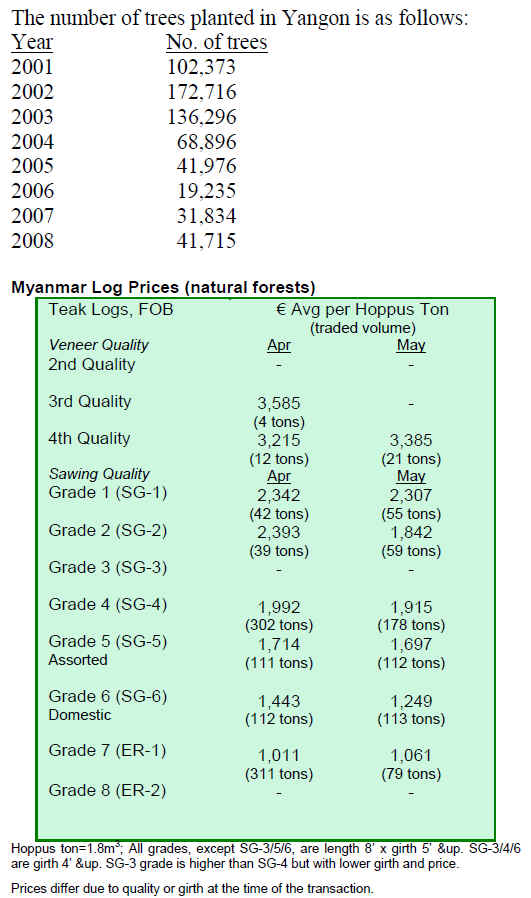

6. INDIA
Recent trends show Indian forest products business
booming
Indian corporate results for the year ending 31 March 2009
showed excellent progress compared with the previous
year¡¯s results. The strong Indian economy and favorable
trading factors has strengthened optimism all around. The
real estate market has recently revived, which has given a
boost to all-round demand for timber and panel products.
In the present economic recession, India has held up
remarkably well, as has its wood and wood products
business.
The new government has better capacity to carry out its
policies to increase and protect flora and fauna in the
country. It is hoped that its pending plans to divide the
Ministry of Forests and Environment will materialize to
better manage both divisions and help achieve a national
target of 33% of land under forest cover. The present
Prime Minister Dr. Manmohan Singh had reduced the
import duty on timber to zero percent when he was the
Finance Minister. With him at the helm of affairs and the
determination of India¡¯s Planning Commission, many
stakeholders are more optimistic he will take measures to
increase forest cover and lessen drought conditions in the
times to come.
Until 1982, India was a net exporting country of wood and
wood products, but since India¡¯s independence, the forest
cover has dropped at an alarming rate - from 23% to 8% -
prompting the government to drastically ban felling in
Indian forests, allow imports of wood and wood products
in a phased manner and ban exports of round as well as
sawn timber. By 1985, all imports of wood and woodbased
products were permitted freely, felling in forests
was curtailed and/or banned and since then the forest
cover has improved from 8% to 24%. This policy still
continues and to date India is a net importer of timber and
panel products and the forest cover is expanding.
India regularly receives logs, sawn timber and panel
products exports from: New Zealand; Malaysia (mainly
Sabah and Sarawak); Indonesia; Myanmar; Côte d¡¯Ivoire;
Ghana; Nigeria; Cameroon; Benin; Togo; the Congo;
Brazil; Ecuador; Panama; Costa Rica; Guatemala;
Venezuela; the US; and Canada. Many of these countries
are exporting plantation materials. One of the major
exports from teak plantations is thinning poles. The teak
poles are quite a popular product with many Indians, who
find them useful for many domestic purposes. They are
primarily converted into sawn timber.
India has four climatic zones: alpine; temperate; subtropical;
and tropical. The forests of India are sub-divided
into 16 forest types producing over 600 species out of
which about 200 provide commercial timber. Coniferous
forests of pine, cedar, fir and spruce and non-coniferous
oak forests are located along the Himalayan range.
The international timber business has a wide variety of
species available to them in different regions of India.
Now that the extractions from natural forests have been
very much restricted, people are using many imported
species. Indian importers go abroad seeking substitutes for
Indian species and often introduce new species
successfully.
Among the most accepted substitutes have been New
Zealand pine (Pinus radiate) as a substitute the for
Himalayan conifer balau. Timbers from the shorea group
from Malaysia and Indonesia are often used in place of sal.
Azobe (West Africa) is used in place of irul and laurel and
similar south Indian hardwoods. Padouk and bubinga
(West Africa) may also be used to replace local padouk
and rosewood. Merbau from Indonesia has been a great
success in replacing bijasal and karimarudu (laurel). Aini
(Artocarpus hirsuta), keruing and gurjan have helped
replace local hollong and kalpen.
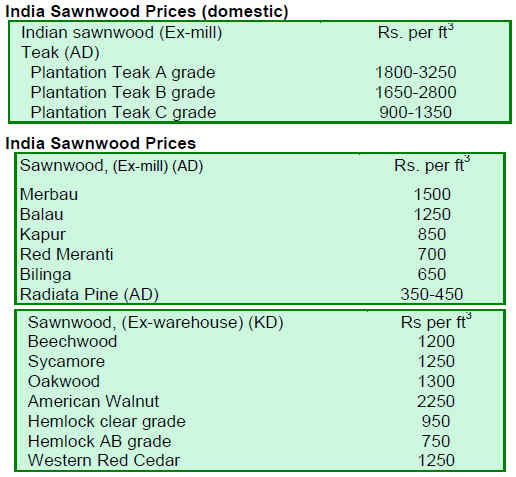
7. BRAZIL
Aça¨ª palm residue seen as new energy source
A new source of energy is being sought to replace
traditional energy sources: the seed of the aça¨ª palm tree.
According to Ag¨ºncia Sebrae de Not¨ªcias/Ecodebate, the
seed of the plant is discarded in the food production
process and has become an environmental liability because
the decomposing seeds pollute the soil and water.
According to local entrepreneurs, the use of the aça¨ª seed
as a source of energy generates jobs and income in local
communities. Moreover, this method of energy generation
is less problematic during environmental inspections and
helps protect the environment.
A growing concern for the environment has encouraged
the search for more sustainable energy production. In the
state of Amazonas, operators of the clay oven have
focused on environmentally friendly new energy sources.
The ceramic making and clay oven clusters of the
municipalities of Iranduba and Manacapuru have
developed a project encouraging the use of materials such
as wood waste and residues of the aça¨ª palm tree as fuel.
Currently, the 15 companies that compose the cluster in
both municipalities utilize 50% of the wood residues. They
come primarily from residues from sawmills and furniture
industries, tree pruning leftovers, and even the demolition
of wooden houses.
Timber theft still rampant in Amazon region
Timber theft is common in one of the most devastated
regions in the Amazon, the northeastern part of Par¨¢ state,
reports G1/Jornal Nacional. In the region, an illegal
scheme involves illegal timber transport, drivers without
licenses and timber without proper documentation.
In the municipality of Tailândia, old trucks are adapted for
timber transportation. The logs are transported without a
¡®forest form¡¯, a mandatory document that must accompany
any timber load. In Concordia of Par¨¢, sawmills¡¯
employees where illegal logs are delivered have confirmed
irregularities.
The government of Par¨¢ estimates that illegal timber
activities generate BRL4 billion a year and notes that there
are no conditions for the state government, the federal
agency, or municipal institutions to adequately control the
illegal timber trade. There are many State Road Police
checkpoints along the highway, but the police have said
there have not been much illegal timber seizures along this
route because the timber trucks loaded with illegal timber
do not use it.
No respite for Brazil¡¯s wood products exports
Brazil¡¯s wood products exports (except pulp and paper)
plunged 41% by value compared to the same period in
2008. The charts below show the volume and value of
Brazil¡¯s exports for May 2009 compared to the same
month a year earlier:
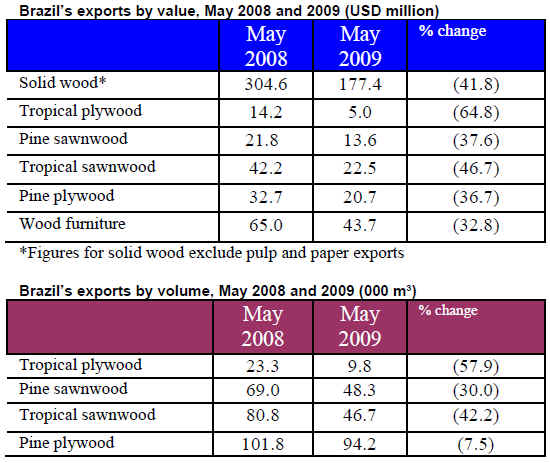
Argentina restricts imports of Brazilian furniture
Argentina's furniture sector has imposed a 35% cutback in
imports of Brazilian furniture to Argentina, reported O
Estado de São Paulo. This percentage was based on 2008
figures and decided after hours of discussions in Buenos
Aires, during which Argentine furniture entrepreneurs
tried to restrict more than 40% of exports when compared
to last year¡¯s total.
The Argentine manufacturers state that Argentina is facing
an ¡®invasion¡¯ of Brazilian products. In the midst of the
international crisis, local businesses are calling for
protection from so called ¡®asymmetries¡¯ in relation to
Brazilian manufacturers. Argentine trade barriers, which
include a non-automatic licensing process, quotas, value
criterion, anti-dumping measures, among others, affect
14% of Brazilian exports to the country.
In 2008, Brazil exported USD155 million worth of all
furniture types to Argentina. For wooden furniture, sales
reached USD41 million. However, between January and
March 2009, Brazil exported only USD16.5 million in
furniture. The agreement on furniture trade between Brazil
and Argentina is valid for one year and ends on 31
December 2009. At the next negotiation in December,
Brazilian entrepreneurs hope Argentina will remove
barriers to trade between the two nations in 2010.
Par¨¢ state braces for reduced timber exports in June
The Association of Timber Exporters of State of Par¨¢
(AIMEX) says the sharp drop of timber exports
experienced over the past few months by the timber sector
has leveled off. According to O Liberal, exports continue
to be very low and there was no expectation of
improvement. However, the domestic market has signaled
a positive reaction to boost timber use by announcing a
federal government housing program called ¡®My House,
My Life¡¯. The sector¡¯s timber exports fell 60% before
stabilizing in recent months, a possible sign that markets
could be improving.
The timber export sector in Par¨¢ was one of the most
affected by the international crisis. As the economic
downturn hit many countries, mainly the US real estate
sector, timber producers in Par¨¢ were also affected in their
business deals with main buyers. AIMEX noted internal
problems of the state that have halted timber production,
such as the lack of institutional structure to issue
environmental licenses. If this issue is resolved, it would
be easier to resume production. Entrepreneurs have the
creativity to overcome this problem by diversifying
production and searching for new customers, although
bureaucratic barriers often interfere with the development
of the sector.
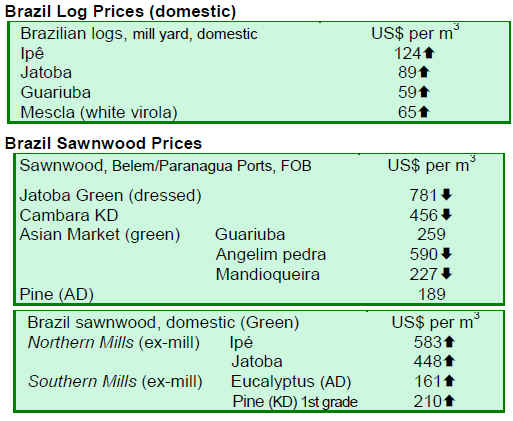
8.
PERU
Japan loans Peru USD120 million for forest
conservation
Peru has just received a 40-year loan worth USD120
million from Japan to conserve 55 million hectares of
forests in the Amazon. Environment Minister Antonio
Brack Egg said that protected areas, land belonging to
Indian communities and those lands for permanent
production would likely benefit from the loan. Brack noted
that the protection of this area would likely offset 20
billion tons of carbon dioxide.
OSINFOR welcomes new President
The Supervisory Agency for Forest Concessions
(OSIFOR), has a new president, Mr. Richard Bustamante
Morote. The incoming president said illegal harvesting in
Peru to exploit natural resources should be stopped. He
noted the importance of the government¡¯s role in
protecting and managing forests and wildlife.
Wood enterprises to invest more than USD300 million
According to the General Manager of Exports,
Transformation, Industry, Commercialization and Services
of Ilo (Ceticos Ilo), Ilo will provide benefits to the timber
industry until 31 December 2012. There are four wood
companies that will develop a wood-based business to
save costs on exports with aggregated value. To save
costs, exports will move through the Port of Ilo where the
wood will be dried. There will also be an export test to
determine the time it takes to move a product from Madre
de Dios to Ilo.
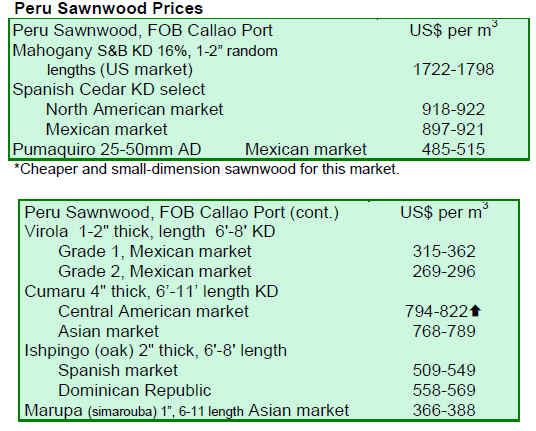
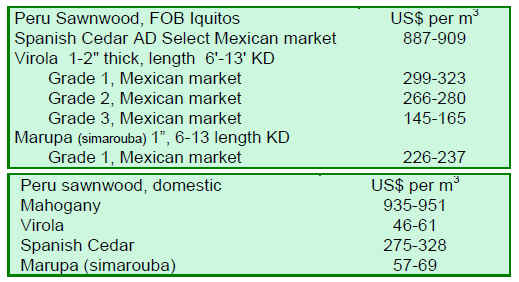
9. BOLIVIA
Decline in forest products exports in first quarter
Forest products exports in the first quarter of 2009 showed
a decline for the second consecutive year, from USD42.67
million in 2008 to USD38.26 million in 2009, a drop of
10.27%. Of these exports, the value of wood products fell
USD28.78 million in 2008 to USD26.03 million in 2009, a
corresponding decline of 9.55%. This decreasing trend has
continued since 2007, the peak year for forestry exports,
when exports reached USD45.48 million in the period of
January to March.
Wood and wood products are among Bolivia¡¯s nontraditional
exports. Soy and its derivatives represent 28%
of total non-traditional exports, followed by wood and
wood-based products at 11% and chestnuts at 5%.
Forest products have increased their share in domestic and
international markets, 3.35% and 16% respectively. This is
attributed to the sharp drop in natural gas exports, one of
its main exports, for which the value has fallen by almost
USD2 billion in the last year.

10.
Guyana
Competitive bidding process for Guyana kiln drying
project
The Guyana Forestry Commission (GFC) has received
funding from the ITTO through the execution of the
project PD 401/06 Rev.2 (I) ¡®Value Adding and Kiln
Drying of Commercial Timbers by Small Scale
Community Saw Millers in Guyana¡¯ to purchase and
install three small kiln dryers for identified communities.
The GFC now invites bids from suitable bidders for the
supply and installation of three kiln dryers.
Bidding will be conducted through the International
Competitive Bidding (ICB) procedures specified in the
ITTO Guidelines for the Selection and Employment of
Consultants and Procurement of Goods and Services,
Second Edition, November 2008. The complete technical
specification of the kilns can be found on the GFC
Website www.forestry.gov.gy or requested via an email
sent to project.coordinator@forestry.gov.gy. Further
information can also be requested by mail sent to the email
address above.
Bids must be delivered to the following address on or
before 9am, 1 September 2009: The Commissioner of
Forests; Guyana Forestry Commission; Lot 1 Water Street;
Kingston, Georgetown, Guyana. Bids are to be submitted
in sealed envelopes - electronic bidding will not be
permitted. Late bids will be rejected.
Greenheart and Purpleheart maintain strong trends
Log prices for greenheart have been favorable overall,
while purpleheart has seen strong increases up to USD250
per m³ for the period of 1-15 June 2009 compared to the
period 16-31 May 2009. This has been one of the highest
prices for this species in log form recorded over the 2009
period. Prices for undressed sawnwood (621/634) have
been fairly stable, while prices for dressed sawnwood have
decreased for the period 1-15 June 2009 compared to the
period 16-31 May 2009. Roundwood prices have
increased for the period of 2009 against the same period of
2008. Plywood prices have declined marginally from last
fortnight by approximately 10% in the BB/CC category.
Value-added products such as outdoor/garden furniture
continue to contribute to export value earnings, which
were largely maintained over this period in 2009 against
the same period in 2008. Non-timber forest products
(NTFPs) also contributed to the export value earnings and
were favorable against the same period of 2008. The
Caribbean market remains the principal destination for
these value-added product category and NTFPs.
Guyana sets pace for combatting illegal logging
Guyana is moving towards completion of a project on
¡®Improving the detection and prevention of illegal logging
and illegality in shipment and trade of wood products in
Guyana¡¯, PD 440/07 (M/I), which aims at enhancing
legality through the application of an integrated approach
to forest law enforcement.
Through the project, Guyana now has in place a baseline
of remote sensing national coverage using satellite
coverage at a medium resolution complemented by high
resolution radar data. These remote sensing analyses have
been conducted using a change detection system
developed in line with the Guyana Forestry Commission¡¯s
guidelines and standards for forest management and
monitoring, and takes into consideration various natural
resources utilization including mining and agriculture.
Regulation of forest management has been rapidly
evolving in Guyana and the Guyana Forestry Commission
(GFC) takes an active and vigilant role in monitoring and
promoting sustainable forest management practices.
Reliable information on illegal forest harvesting activities
is often difficult to obtain. Left unchecked, illegal logging
and subsequent trade of timber represent a substantial
threat to sustainable forest management in many countries.
Working with International Remote Sensing Specialist,
PŐYRY, the project seeks to improve sustainable
management of forest resources, and to identify areas
where illegal harvesting of tropical timber is taking place
by collecting accurate geographical information on
deforestation along an indicators system developed.
Remotely sensed data (satellite images spanning from
2005 to 2009) has been used to detect deforestation
activities and generate GIS layers documenting logging
activities and road networks. Such information has
assisted GFC in targeting areas of change and mobilizing
the necessary resources to undertake enforcement
measures. Some of the challenges encountered include:
the limitations of using medium resolution images to
detect change in a forest where change is usually relatively
small in nature; the cost attached to such securing satellite
images; and the issue of high cloud cover associated with
satellite data. These were addressed by selecting an
approach of ground truthing and aerial surveys, use of a
combination of radar and satellite data and integrating
hotspot monitoring, as well as selection of image providers
which produce accurate and cost effective data.
The project has been successful in conducting satellite
image analyses to detect logging, mining and road clearing
activities. Additionally, the project developed legality
indicators and applied these to a GIS environment to
assess occurrences of illegality and their impact on
deforestation. Further, an integrated geographic database
has been established for the storage and maintenance of
the acquired satellite imagery and GIS layers in order to
detect and monitor forest disturbance. The GIS is designed
to store and permit queries of temporal attributes of these
layers. Overall, the GFC is now able to integrate GIS and
remote sensing technology in resource allocation required
for forest law enforcement and provides training on
operating and maintaining the tools developed in handling
such datasets.
Over the coming two months, the Guyana Forestry
Commission will be completing all activities for this
project and is currently continuing training to enhance
capacity for continued successful implementation of this
initiative. The results have already contributed greatly to
the work that Guyana has undertaken through the World
Bank¡¯s Forest Carbon Partnership Facility and other
national climate change mitigation initiatives.
Overall, the project has lead to the enhancement of legality
and sustainable forest management in an innovative way
while ensuring future sustainability of various natural
resources in Guyana.
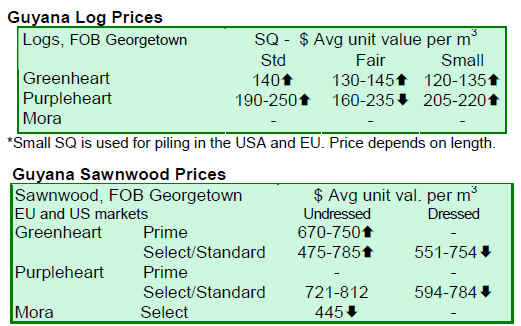
|